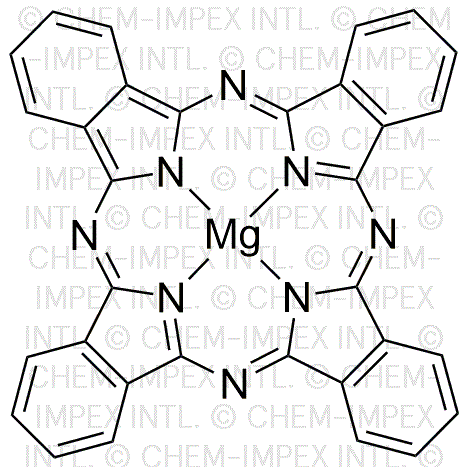Magnesium(II) phthalocyanine is widely utilized in research focused on:
- Photovoltaic Cells: This compound is used in the development of organic solar cells, enhancing light absorption and improving energy conversion efficiency.
- Catalysis: It serves as a catalyst in various chemical reactions, particularly in the synthesis of organic compounds, offering a more sustainable approach compared to traditional catalysts.
- Biomedical Applications: Magnesium(II) phthalocyanine is explored for photodynamic therapy, where it helps in targeting and destroying cancer cells with minimal side effects.
- Colorants and Dyes: Its vibrant color properties make it suitable for use in inks and coatings, providing excellent stability and durability in various applications.
- Electrochemical Sensors: This compound is employed in the development of sensors for detecting environmental pollutants, offering high sensitivity and selectivity.
General Information
Properties
Safety and Regulations
Applications
Magnesium(II) phthalocyanine is widely utilized in research focused on:
- Photovoltaic Cells: This compound is used in the development of organic solar cells, enhancing light absorption and improving energy conversion efficiency.
- Catalysis: It serves as a catalyst in various chemical reactions, particularly in the synthesis of organic compounds, offering a more sustainable approach compared to traditional catalysts.
- Biomedical Applications: Magnesium(II) phthalocyanine is explored for photodynamic therapy, where it helps in targeting and destroying cancer cells with minimal side effects.
- Colorants and Dyes: Its vibrant color properties make it suitable for use in inks and coatings, providing excellent stability and durability in various applications.
- Electrochemical Sensors: This compound is employed in the development of sensors for detecting environmental pollutants, offering high sensitivity and selectivity.
Documents
Safety Data Sheets (SDS)
The SDS provides comprehensive safety information on handling, storage, and disposal of the product.
Product Specification (PS)
The PS provides a comprehensive breakdown of the product’s properties, including chemical composition, physical state, purity, and storage requirements. It also details acceptable quality ranges and the product's intended applications.
Certificates of Analysis (COA)
Search for Certificates of Analysis (COA) by entering the products Lot Number. Lot and Batch Numbers can be found on a product’s label following the words ‘Lot’ or ‘Batch’.
*Catalog Number
*Lot Number
Certificates Of Origin (COO)
This COO confirms the country where the product was manufactured, and also details the materials and components used in it and whether it is derived from natural, synthetic, or other specific sources. This certificate may be required for customs, trade, and regulatory compliance.
*Catalog Number
*Lot Number
Safety Data Sheets (SDS)
The SDS provides comprehensive safety information on handling, storage, and disposal of the product.
DownloadProduct Specification (PS)
The PS provides a comprehensive breakdown of the product’s properties, including chemical composition, physical state, purity, and storage requirements. It also details acceptable quality ranges and the product's intended applications.
DownloadCertificates of Analysis (COA)
Search for Certificates of Analysis (COA) by entering the products Lot Number. Lot and Batch Numbers can be found on a product’s label following the words ‘Lot’ or ‘Batch’.
*Catalog Number
*Lot Number
Certificates Of Origin (COO)
This COO confirms the country where the product was manufactured, and also details the materials and components used in it and whether it is derived from natural, synthetic, or other specific sources. This certificate may be required for customs, trade, and regulatory compliance.


